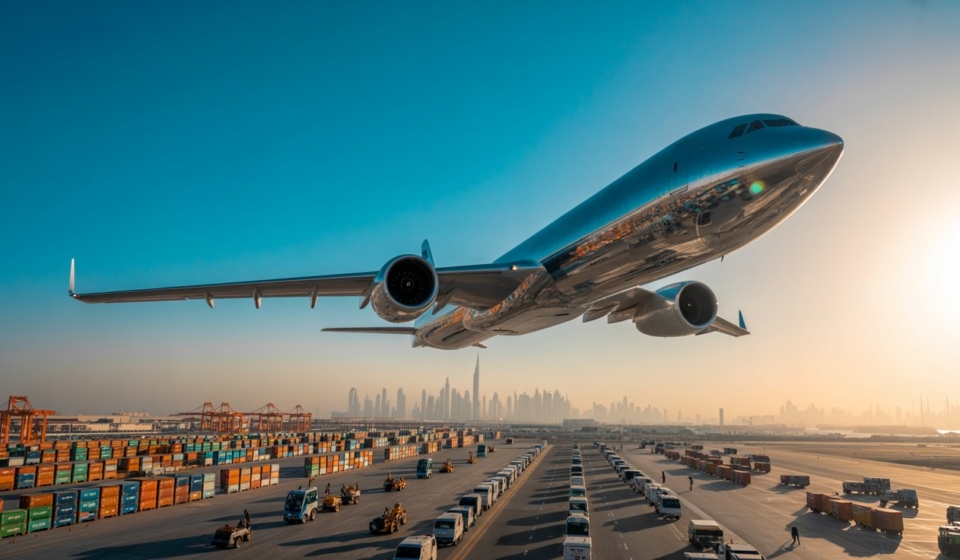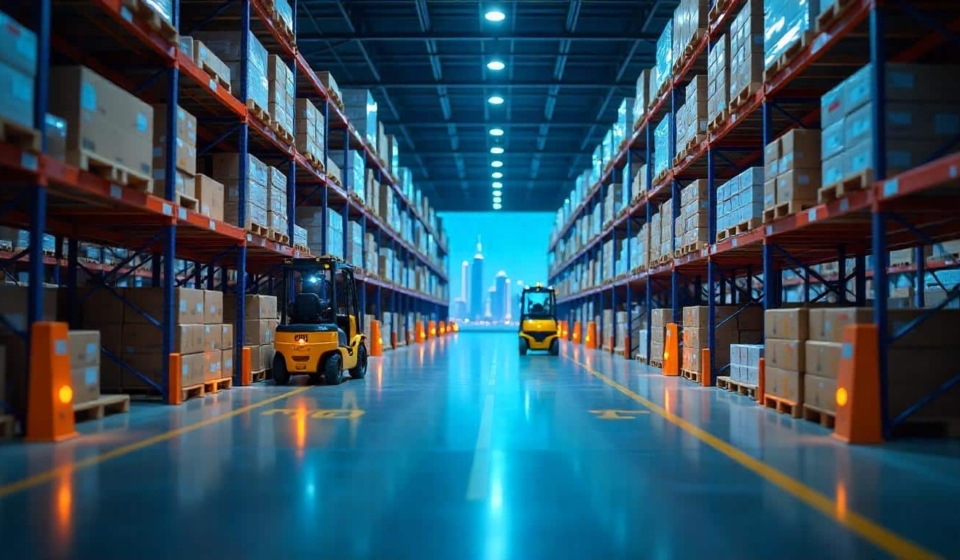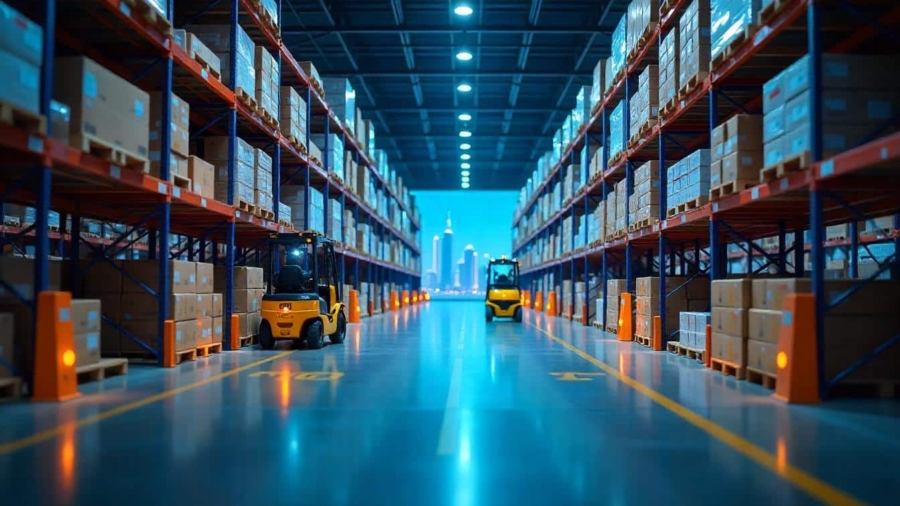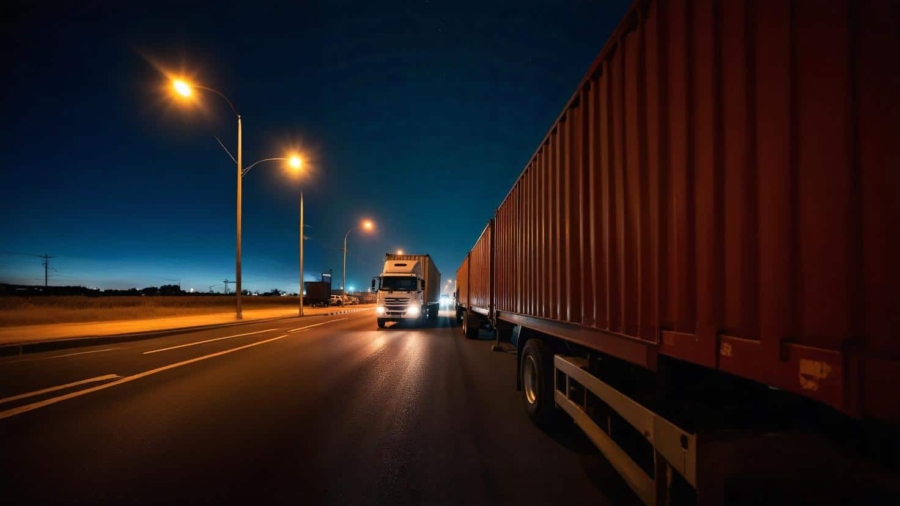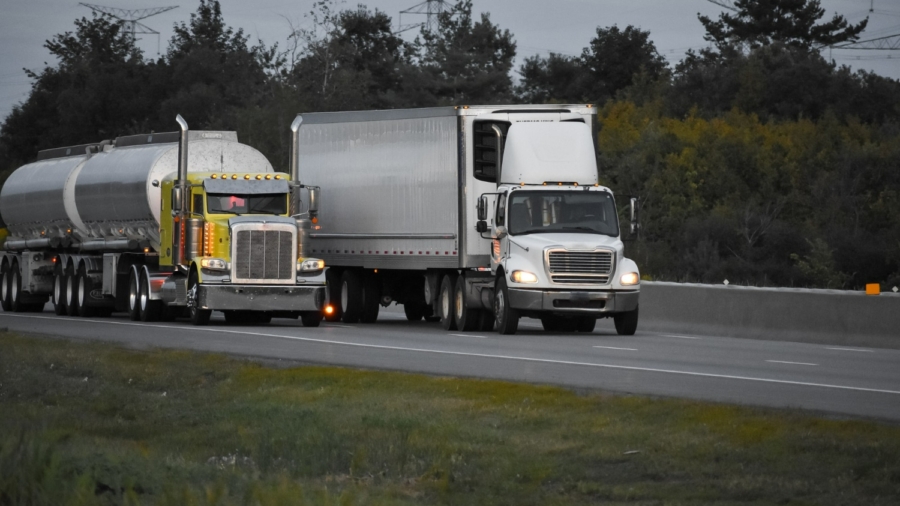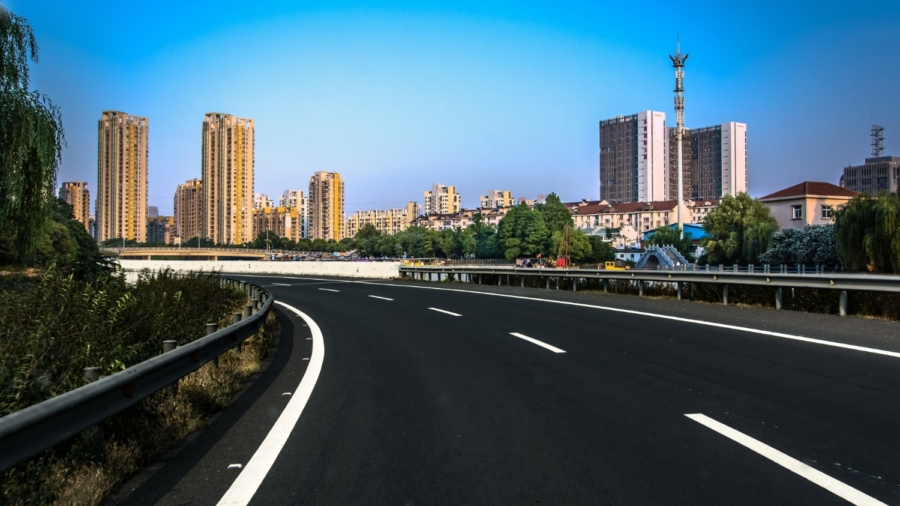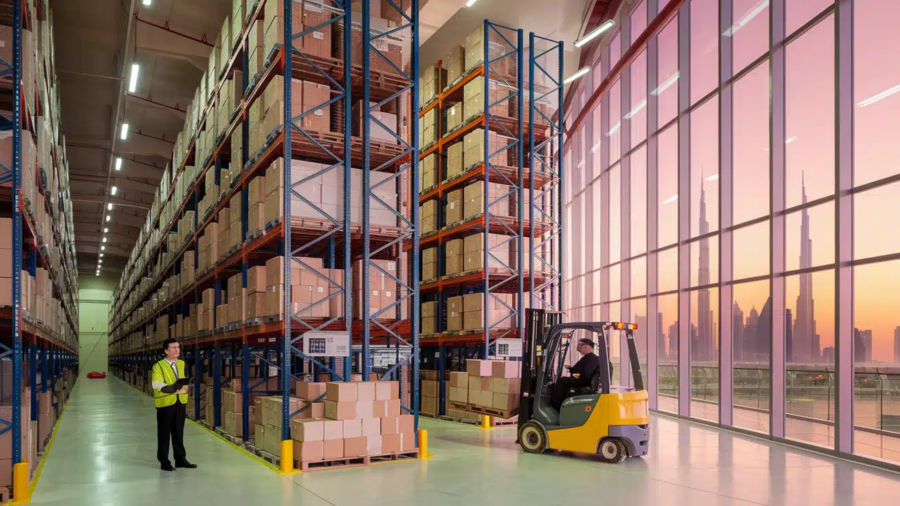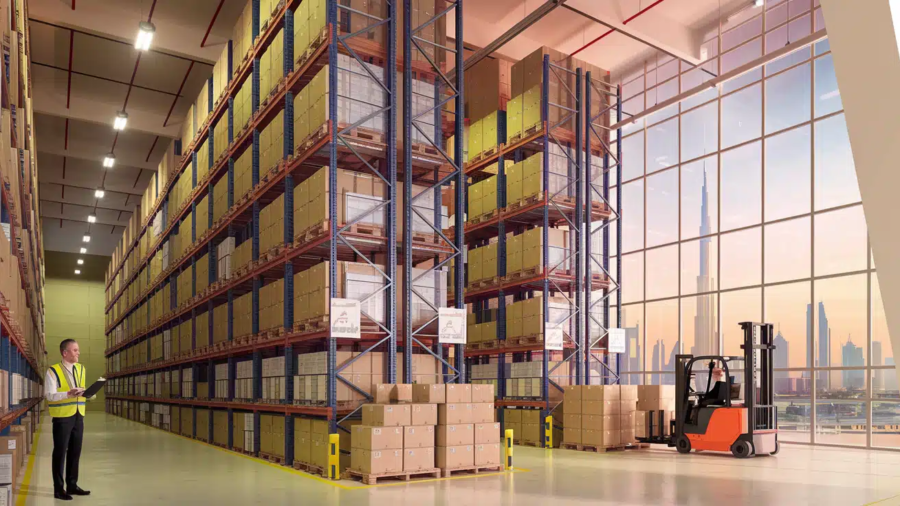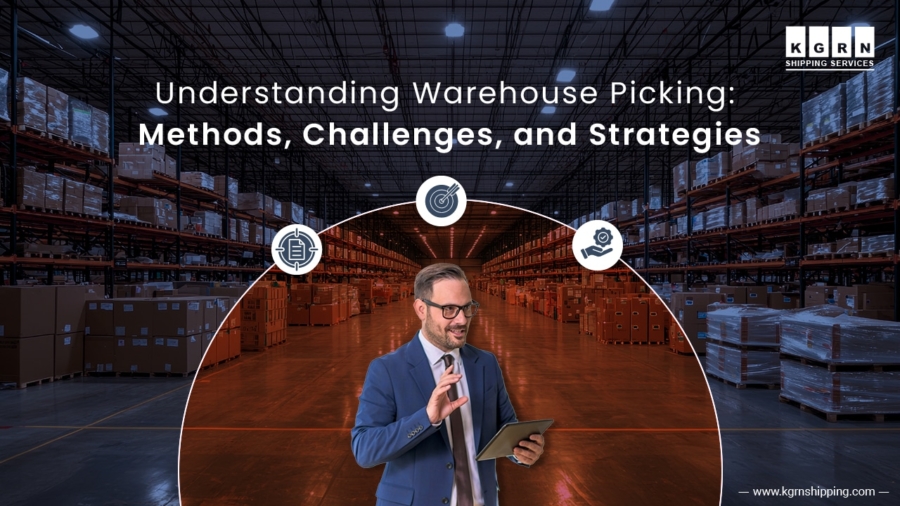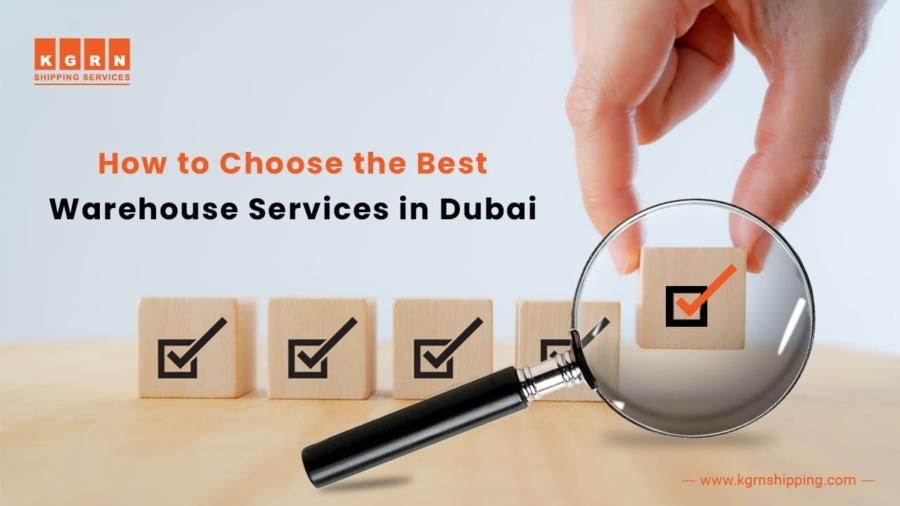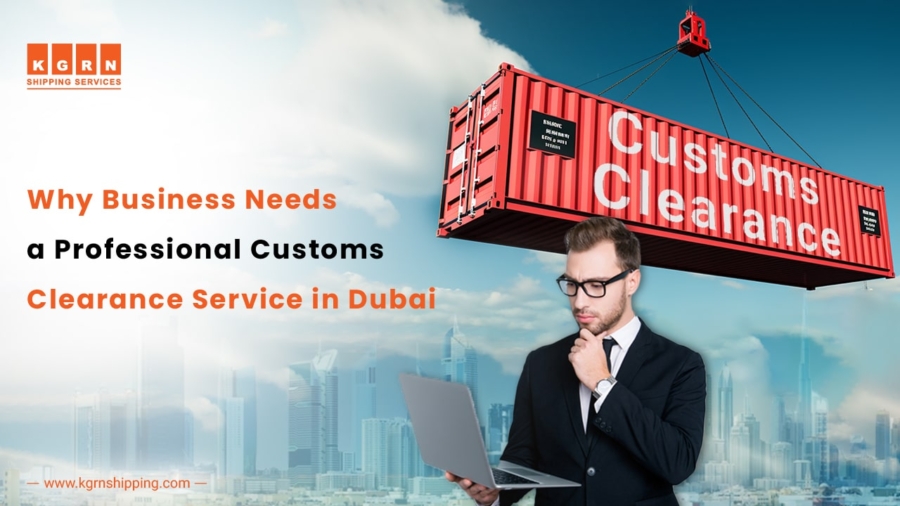Discover how strategic warehousing in Dubai can revolutionize your supply chain efficiency. Learn about smart technologies, sustainable practices, and strategic locations that can enhance inventory management, reduce costs, and improve customer satisfaction.
Why Roadway Shipping is the Best Choice for Businesses in Dubai
Dubai, a global hub for trade and commerce, thrives on efficient logistics and seamless supply chains. As businesses in this dynamic city continue to grow, the demand for reliable, cost-effective, and flexible shipping solutions has never been higher.
How Technology is Transforming Customs Clearance in Dubai
Dubai has solidified its reputation as a global trade hub, attracting businesses worldwide with its strategic location, cutting-edge infrastructure, and progressive policies. At the core of this thriving trade ecosystem lies a vital process: customs clearance. Traditionally perceived as a complex and time-intensive procedure, customs clearance in Dubai is undergoing a remarkable transformation fueled by technological innovation.
From blockchain technology enhancing transparency to artificial intelligence streamlining operations, the advancements in customs processes are not only improving efficiency but also reshaping the way businesses engage in international trade. As a trusted partner in logistics solutions, KGRN Shipping Service LLC is at the forefront of this evolution, helping clients navigate the complexities of modern customs clearance with ease. In this blog, we will explore how technology is revolutionizing customs clearance in Dubai, the benefits it brings to businesses, and the vital role KGRN Shipping plays in this dynamic landscape. Join us as we delve into the future of trade facilitation in one of the world’s most vibrant economic hubs.
Technology As A Catalyst In Customs Clearance In Dubai
- Dubai Customs has implemented blockchain and AI technologies to enhance transparency and efficiency.
- Digital platforms have streamlined documentation and risk management processes.
- Businesses benefit from faster clearance times, reduced costs, and improved compliance.
- Despite challenges, technological solutions are continuously improving the customs clearance experience in Dubai.
The Importance of Customs Clearance in Dubai
Customs clearance is a critical component of international trade. It involves ensuring that goods entering or leaving a country comply with local regulations and are accompanied by the necessary documentation. In Dubai, where trade plays a vital role in the economy, efficient customs clearance processes are essential for maintaining smooth supply chain operations.
However, traditional customs clearance methods often involved manual paperwork, lengthy processing times, and high costs. This created bottlenecks that could delay shipments and disrupt business operations. Today, technology is addressing these challenges by automating processes and introducing innovative solutions.
Key Technologies Transforming Customs Clearance
1. Electronic Data Interchange (EDI)
Electronic Data Interchange (EDI) is a system that allows businesses to exchange critical trade and customs-related documents electronically. By replacing traditional paper-based methods, companies can submit invoices, customs declarations, and certificates digitally, reducing processing time and manual intervention.
Some of the key benefits of EDI include faster submission of documents, which significantly reduces clearance time. Automation helps minimize human errors, ensuring compliance with customs regulations. The shift to digital documentation eliminates the need for paper-based processes, lowering administrative costs. Standardized document formats simplify communication between traders, logistics providers, and customs authorities.
For example, companies like KGRN Shipping Service LLC use EDI systems to streamline document submission to Dubai Customs, ensuring quick clearance and avoiding unnecessary delays. The implementation of EDI in UAE’s customs clearance has significantly improved efficiency in trade facilitation.
2. Blockchain Technology
Blockchain is a decentralized and secure digital ledger technology that records transactions in a transparent and tamper-proof manner. It enables multiple stakeholders—including businesses, shipping companies, and customs authorities—to access real-time, unalterable records of shipments and documentation.
This technology enhances transparency by providing all involved parties with real-time access to shipment records, reducing disputes and ensuring compliance. The data stored on blockchain is secure and tamper-proof, minimizing the risk of fraud and document forgery. Customs authorities can verify trade documents instantly, leading to faster clearance processes. Additionally, goods can be traced throughout the entire supply chain, ensuring authenticity and regulatory compliance.
Dubai is actively exploring blockchain-based customs clearance solutions. Dubai Customs has already implemented blockchain technology to improve trade transparency and security. Logistics providers like KGRN Shipping Service LLC use blockchain to verify bills of lading, certificates of origin, and shipment details, reducing paperwork and manual processing.
3. Artificial Intelligence (AI) and Machine Learning
Artificial Intelligence (AI) and Machine Learning (ML) are transforming customs clearance by automating risk assessments, detecting anomalies, and predicting potential delays. These technologies analyze large volumes of trade data to enhance decision-making and streamline operations.
AI-powered systems automate the verification of trade documents, significantly reducing processing time. Machine learning algorithms analyze trade patterns and historical data to identify high-risk shipments for closer inspection. Predictive analytics help forecast possible clearance delays and recommend alternative solutions. AI also plays a crucial role in fraud detection by identifying smuggling attempts and discrepancies in trade declarations.
KGRN Shipping Service LLC integrates AI-driven tools to analyze trade patterns, detect inconsistencies in documentation, and optimize customs compliance. By using AI-powered customs platforms, businesses can clear low-risk shipments faster while ensuring detailed inspections for high-risk cargo.
4. Cloud Computing
Cloud computing provides businesses with centralized, web-based platforms to store, manage, and share customs-related documentation. Unlike traditional on-premise systems, cloud platforms offer real-time access to critical data from anywhere in the world.
Cloud-based platforms enhance accessibility, allowing traders, shipping companies, and customs officials to retrieve documents from any location. Seamless collaboration between different stakeholders ensures faster and more efficient processing. Reducing reliance on physical storage and IT infrastructure leads to significant cost savings. Businesses benefit from real-time tracking of their shipment clearance status, improving supply chain visibility.
KGRN Shipping Service LLC employs cloud-based customs platforms to track shipments, manage compliance documentation, and enable real-time collaboration with customs officials. By adopting cloud technology, businesses gain improved control and transparency over their customs processes.
5. Internet of Things (IoT)
The Internet of Things (IoT) enables real-time tracking of shipments by equipping cargo containers with smart sensors and GPS devices. These IoT-enabled solutions monitor cargo conditions, track movements, and provide automated alerts in case of deviations from predefined parameters.
IoT devices offer real-time monitoring of shipment conditions, including temperature, humidity, and security status. Automated alerts notify businesses of any deviations from required storage conditions, helping prevent damage to sensitive goods. Customs authorities use IoT tracking to ensure cargo integrity and compliance with trade regulations. Real-time GPS tracking enhances security by preventing cargo theft and unauthorized access.
KGRN Shipping Service LLC uses IoT-enabled smart containers to provide real-time updates on cargo status, especially for temperature-sensitive shipments such as pharmaceuticals and perishable goods. These IoT solutions help businesses meet Dubai Customs’ regulations while ensuring the quality and safety of their cargo.
Traditional vs Technological Customs Clearance
| Feature | Traditional Customs Clearance | Technological Customs Clearance |
| Document Submission | Manual paperwork | Automated via EDI |
| Processing Time | Lengthy | Significantly reduced |
| Risk Assessment | Manual inspections | AI-driven analysis |
| Transparency | Limited | Enhanced via blockchain |
| Cost | High due to inefficiencies | Lower due to automation |
How KGRN Shipping Leverages Technology To Provide Cost-effective Customs Clearance Services
As one of Dubai’s premier logistics providers, KGRN Shipping Service LLC has embraced cutting-edge technologies to transform its customs clearance services:
- Implementing advanced EDI systems for seamless document submission.
- Utilizing blockchain platforms to ensure secure handling of sensitive documents.
- Integrating AI tools into risk assessment workflows for faster processing times.
- Offering cloud-based solutions that allow clients real-time access to shipment data.
- Deploying IoT-enabled smart containers for enhanced cargo monitoring during transit.
These innovations enable KGRN Shipping Service LLC to provide reliable and efficient services tailored to meet the unique needs of its clients across various industries.
Conclusion
The technological transformation of customs clearance in Dubai represents a significant leap forward in trade facilitation. By embracing blockchain, AI, and digital platforms, Dubai Customs has set a new standard for efficiency and transparency in global trade operations. For businesses operating in or through Dubai, partnering with experienced logistics providers like KGRN Shipping Service LLC can be instrumental in fully leveraging these technological advancements.
As Dubai continues to innovate and refine its customs processes, the emirate is solidifying its position as a global leader in smart trade solutions. The ongoing digital evolution promises to further enhance Dubai’s attractiveness as a business hub, driving economic growth and setting a benchmark for customs operations worldwide.
Essential Safety Measures for Road Freight in the UAE
Road freight plays a critical role in the United Arab Emirates (UAE), serving as a backbone for its thriving economy and logistics sector. With its strategic location as a global trade hub, ensuring the safety of road freight operations is paramount. The UAE has implemented stringent regulations and advanced technologies to enhance road safety and reduce accidents. This blog explores essential safety measures for road freight in the UAE, focusing on compliance with laws, vehicle maintenance, driver training, and innovative solutions.
Vehicle Maintenance
Maintaining freight vehicles is a cornerstone of road safety, especially due to desert environment in UAE, where high temperatures can strain equipment. Regular upkeep minimizes the risk of breakdowns and accidents. Operators should prioritize the following:
- Routine Inspections: Check brakes, tires, lights, and other critical components regularly.
- Engine and Transmission Care: Follow manufacturer servicing schedules to ensure optimal performance.
- Cooling Systems: Maintain these to prevent overheating in extreme heat.
- Safety Features: Ensure airbags, seatbelts, and other systems are fully operational.
In the UAE, vehicles must also meet roadworthiness standards, often requiring periodic inspections by authorized agencies to comply with local laws.
Driver Training and Certification
Skilled drivers are essential for safe road freight operations. In the UAE, where diverse road conditions and strict traffic laws prevail, proper training and certification are non-negotiable. Key elements include:
- Defensive Driving Courses: Equip drivers to handle various road scenarios safely.
- Traffic Law Awareness: Ensure familiarity with UAE-specific regulations.
- Cargo Handling Skills: Train drivers in secure loading and unloading techniques.
- Licensing: Obtain a commercial driver’s license (CDL) or equivalent certification.
Numerous training programs are available across the UAE, preparing drivers for the unique demands of road freight transport.
Cargo Securing and Handling
Improperly secured cargo can shift or fall during transit, posing significant safety risks. In the UAE, operators must adopt best practices to protect goods and comply with regulations:
- Restraints: Use straps, chains, or nets to secure loads effectively.
- Weight Distribution: Balance cargo evenly and stay within legal weight limits.
- Hazardous Materials: Follow specific guidelines for securing dangerous goods.
- Staff Training: Educate workers on safe loading and unloading procedures.
Adhering to the UAE’s cargo regulations is mandatory to avoid penalties and ensure road safety.
Route Planning and Navigation
Effective route planning enhances safety by avoiding hazards like congested roads or construction zones. In the UAE, technology plays a key role in optimizing navigation:
- GPS and Telematics: Monitor vehicle locations and conditions in real time.
- Efficient Routes: Plan paths to reduce travel time and fuel use.
- Road Updates: Stay informed about closures, restrictions, or weather changes.
- Emergency Plans: Prepare for unexpected disruptions.
Optimized routes reduce accident risks and boost operational efficiency for road freight in the UAE.
Compliance with Regulations
The UAE enforces strict regulations to maintain safety and order in road freight operations. Operators must stay compliant to avoid penalties and ensure smooth operations:
- Permits and Licenses: Secure all necessary documentation for commercial vehicles.
- Weight and Size Limits: Adhere to restrictions on load dimensions.
- Driving Hours: Follow rules on rest periods to prevent driver fatigue.
- Emission Standards: Meet environmental and safety requirements.
Non-compliance can lead to fines, vehicle impoundment, or legal consequences, making regulatory awareness a priority.
Advanced Technologies Enhancing Safety in Road Freight:
1. Remote Vehicle Tracking Systems
Using GPS and telematics, fleet managers can now monitor vehicle location, speed, and driver behavior in real-time. These systems provide instant alerts for speeding, harsh braking, or route deviations, enabling swift corrective actions. The constant visibility ensures that safety protocols are followed and helps reduce the risk of accidents caused by driver fatigue or negligence.
2. AI-Enabled In-Cabin Cameras
Artificial intelligence-powered cameras analyze live video feeds to detect risky behaviors such as distracted driving, drowsiness, and non-compliance with safety measures like seatbelt usage. These smart systems automatically generate reports and issue warnings to both drivers and fleet supervisors, promoting a culture of accountability and safety awareness.
3. Smart Traffic Management Systems
By leveraging real-time traffic data, adaptive traffic control systems dynamically adjust signal timings and suggest optimal routes for freight vehicles. This reduces delays caused by traffic jams, minimizes exposure to high-risk intersections, and enhances the overall flow of goods through urban areas, all while improving road safety for other motorists and pedestrians.
4. Collision Avoidance and Driver Assistance Systems
Equipped with radar, lidar, and proximity sensors, modern trucks now feature collision avoidance technologies that warn drivers about potential hazards, such as sudden stops by vehicles ahead or obstacles in blind spots. Some systems also include automatic emergency braking, which can prevent accidents when drivers fail to react in time.
The Impact of the New Federal Law on Heavy Vehicle Operations in the UAE
The UAE’s new federal law regulating heavy vehicle operations, which came into effect on October 1, 2023, is set to transform the logistics and transportation sector. By introducing stricter weight limits and safety measures, the law aims to enhance road safety, protect infrastructure, and optimize heavy vehicle operations across the country.
Here’s a closer look at how this law impacts heavy vehicle operations:
Weight Limit Enforcement
The new law caps the maximum weight of heavy vehicles at 65 tonnes, including their loads. This regulation applies to trucks and other commercial vehicles weighing over 2.5 tonnes when empty. It’s estimated that nearly 28% of current truckloads exceed this limit, meaning many operators will need to adjust their practices to comply with the new rules.
Grace Period for Compliance
To help businesses adapt, the law provides a four-month grace period before penalties are enforced starting February 1, 2024. This allows vehicle owners and operators enough time to make necessary changes, such as redistributing loads or upgrading equipment to meet the requirements.
Enhanced Road Safety
Heavy vehicles are involved in a significant number of road accidents in the UAE, often leading to fatalities. The new regulations aim to reduce traffic deaths related to heavy vehicles by up to 50% per 100,000 people. By enforcing weight limits and improving monitoring systems, the government is taking a proactive approach to making roads safer for everyone.
Economic and Environmental Benefits
The law isn’t just about safety—it also has broader economic and environmental implications:
- Reduced Maintenance Costs: By limiting vehicle weights, the strain on road infrastructure will decrease, saving an estimated AED 200 million annually in road repair costs.
- Lower Carbon Emissions: Heavy vehicles contribute significantly to carbon emissions. The new law aims to cut emissions by five billion kilograms by 2032, supporting the UAE’s sustainability goals.
Exemptions for Critical Services
Certain vehicles are exempt from these regulations, including those operated by security forces, military units, police departments, and civil defense authorities. This ensures that essential services can continue their operations without restrictions that might hinder their effectiveness.
The new federal law is a game-changer for heavy vehicle operations in the UAE. By enforcing weight limits and introducing advanced monitoring systems, it improves road safety while reducing infrastructure damage and environmental impact. Businesses now have an opportunity to align their practices with these regulations during the grace period, ensuring smooth operations in the long term.
Conclusion
Safe road freight operations in the UAE demand a comprehensive approach, integrating vehicle maintenance, driver training, cargo securing, route planning, regulatory compliance, and cutting-edge technology. These essential safety measures protect assets, reduce risks, and contribute to a safer transportation network. Businesses and operators should prioritize these practices and stay updated on best practices and regulations to thrive in the UAE’s dynamic logistics landscape.
How UAE Road Infrastructure Boosts Roadway Shipping Efficiency
The United Arab Emirates (UAE) has emerged as a global leader in logistics and transportation, thanks to its world-class road infrastructure. The country’s strategic investments in modern highways, intelligent traffic systems, and sustainable practices have significantly enhanced roadway shipping efficiency. This blog explores how the UAE’s advanced road infrastructure contributes to the seamless movement of goods, supporting its position as a global logistics hub. These investments not only streamline transportation but also reduce costs and delivery times, making roadway shipping benefits for businesses increasingly significant. As a result, companies operating in the region can capitalize on the efficient supply chain advantages that the UAE offers. Furthermore, enhanced logistics capabilities attract international trade, solidifying the UAE’s reputation as a pivotal player in the global market.
Strategic Planning and Development of Road Networks
One of the key factors behind the UAE’s efficient roadway shipping is its meticulously planned road network. The UAE government has consistently prioritized infrastructure development as part of its long-term economic vision. Roads such as Emirates Road (E611), Sheikh Zayed Road (E11), and Sheikh Mohammed Bin Zayed Road (E311) form the backbone of the nation’s transportation system.
These highways are designed to connect major cities like Dubai, Abu Dhabi, and Sharjah with industrial hubs, ports, and free zones. By ensuring smooth connectivity between urban centers and logistics facilities, these roads reduce transit times for freight shipments. Additionally, their multi-lane designs accommodate high volumes of traffic while minimizing congestion—a critical factor for maintaining supply chain efficiency.
Integration With Ports and Free Zones
The UAE’s road infrastructure is seamlessly integrated with its ports and free zones, which are vital for international trade. Jebel Ali Port in Dubai—one of the busiest container ports globally—is directly connected to major highways like Sheikh Zayed Road and Emirates Road. This integration allows for quick transfer of goods from ships to trucks for onward distribution across the country or region.
Free zones such as Jebel Ali Free Zone (JAFZA) also benefit from this connectivity. Trucks can efficiently transport goods between warehouses, manufacturing units, and export terminals without delays caused by poor infrastructure. This streamlined movement reduces costs for businesses while enhancing overall shipping efficiency.
Advanced Traffic Management Systems
The UAE employs cutting-edge technology to manage its road networks effectively. Intelligent Traffic Management Systems (ITMS) monitor traffic flow in real-time using sensors, cameras, and data analytics tools. These systems help identify bottlenecks or accidents quickly, enabling authorities to redirect traffic or deploy emergency services promptly.
For roadway shipping companies, this translates into fewer delays caused by congestion or unforeseen incidents. Real-time updates allow drivers to choose optimal routes based on current traffic conditions, ensuring timely delivery of goods.
High-Quality Construction Standards
The quality of construction materials used in building UAE roads ensures durability and reliability under heavy usage. Roads are built to withstand extreme weather conditions such as high temperatures during summer months while accommodating heavy freight vehicles.
Sophisticated drainage systems prevent flooding during rare but intense rainfalls—a common issue that disrupts transportation in other regions. By maintaining consistent road quality year-round, the UAE minimizes disruptions that could impact roadway shipping operations.
Sustainability Initiatives in Transportation
Environmental sustainability is a growing focus within the UAE’s transportation sector. The government has implemented eco-friendly practices such as using recycled materials in road construction and installing energy-efficient lighting along highways.
Additionally, initiatives promoting electric vehicles (EVs) include dedicated EV lanes on some roads and charging stations at key locations. For logistics companies adopting green fleets, these measures enhance operational efficiency while aligning with global sustainability goals.
Impact on Cost Savings for Businesses
Efficient road infrastructure directly translates into cost savings for businesses involved in roadway shipping. Reduced transit times lower fuel consumption and vehicle maintenance costs while improving delivery timelines key factors that enhance customer satisfaction.
Moreover, fewer delays mean reduced inventory holding costs for companies relying on just-in-time supply chains. These benefits make the UAE an attractive destination for businesses seeking reliable logistics solutions.
Future Developments: Preparing for Growth
The UAE continues to invest heavily in expanding its road network to meet future demands driven by population growth and increased trade activity. Projects like Etihad Rail aim to integrate railways with existing road networks further enhancing multimodal transport options.
Smart city initiatives incorporating autonomous vehicles and AI-driven traffic management systems are also expected to revolutionize roadway shipping efficiency in coming years.
How the UAE’s Road Infrastructure Compares to Other Countries
The UAE’s road infrastructure ranks among the best globally, showcasing significant advancements compared to many other countries.
Infrastructure Quality
The UAE ranks 5th globally and 1st among Arab countries in road quality, positioning it ahead of countries like Germany and the UK, which are known for their advanced infrastructure.
Singapore, Switzerland, and Austria lead globally in road quality, but the UAE’s modern highways, wide lanes, and advanced traffic management systems make it a standout in the Middle East.
Technological Integration
The UAE integrates advanced traffic management systems and is exploring autonomous vehicles for freight transport. Such innovations place it ahead of many developed nations in terms of future-ready infrastructure.
Role of UAE’s Road Network in Economic Growth
The UAE’s road network had a huge impact in economic growth:
- Connects major ports, airports, and industrial zones for seamless goods movement.
- Enhances accessibility for diverse sectors like tourism, retail, and manufacturing.
- Provides a favorable environment for businesses with efficient transportation options.
- Connects residential areas to commercial hubs, improving quality of life and economic activity.
- Improves access to tourist destinations, enhancing visitor experiences and supporting the tourism sector.
- Ensures seamless movement of goods across different transport channels (road, rail, air).
Conclusion
The UAE’s advanced road infrastructure plays a pivotal role in boosting roadway shipping efficiency by providing seamless connectivity between key economic hubs, integrating technology-driven solutions for traffic management, ensuring high-quality construction standards, embracing sustainability initiatives, and reducing operational costs for businesses. As the country continues investing in innovative projects aimed at enhancing transportation capabilities further, it solidifies its position as a global leader in logistics excellence. Streamline your logistics with KGRN Shipping Service LLC! Offering reliable freight forwarding, custom clearance, and warehousing solutions tailored to your needs.
Contact us today at +971 4557 0204 or visit us at Oxford Towers, Business Bay, Dubai, UAE!
Environmental Regulations for Warehousing & Storage in Dubai
Warehousing and storage are critical components of Dubai’s thriving economy, supporting industries such as logistics, retail, e-commerce, and manufacturing. However, with the rapid industrialization and urbanization of the emirate, environmental sustainability has become a key focus area for regulatory authorities. The government of Dubai has implemented stringent environmental regulations to ensure that warehousing and storage facilities operate in an eco-friendly manner while minimizing their impact on the environment. Let us explore the various environmental regulations governing warehousing and storage processes in Dubai, with a comprehensive overview of compliance requirements, best practices, and the role of regulatory bodies.
Overview of Warehousing in Dubai
Dubai is a global hub for trade and logistics due to its strategic location connecting Asia, Europe, and Africa. The emirate boasts world-class infrastructure, including free zones like Jebel Ali Free Zone (JAFZA), Dubai South, and Dubai Industrial City. These areas house numerous warehouses that cater to diverse industries such as pharmaceuticals, food products, electronics, chemicals, and more.
Warehouses in Dubai range from general-purpose facilities to specialized temperature-controlled warehouses designed for perishable goods or sensitive materials. With this diversity comes a need for strict environmental oversight to ensure sustainable operations.
Key Regulatory Authorities Governing Warehousing in Dubai
Several government entities oversee the environmental regulations applicable to warehousing and storage facilities in Dubai:
- Dubai Municipality (DM): Responsible for enforcing environmental standards related to waste management, air quality control, water conservation, and pollution prevention.
- Dubai Civil Defense (DCD): Ensures fire safety compliance within warehouses while also addressing hazardous material handling.
- Trakhees – Ports Customs & Free Zone Corporation (PCFC): Oversees licensing and compliance within free zones like JAFZA.
- Dubai Environment Department: Focuses on implementing policies related to sustainability and reducing carbon footprints across industries.
- Ministry of Climate Change and Environment (MOCCAE): Sets national-level guidelines for environmental protection that apply across all emirates.
Each authority plays a distinct role in ensuring that warehouse operators adhere to local laws while contributing to broader sustainability goals.
Tracking Progress in Complying with New Regulations
Businesses can effectively track their progress in complying with new regulations by implementing a structured approach that includes using compliance tracking software, maintaining a central compliance file, and conducting regular audits. Here are some strategies to help businesses stay on top of regulatory compliance:
1. Use Compliance Tracking Software
Compliance monitoring system software is designed to manage and track business compliance efforts efficiently. This centralized platform automates the entire compliance process, including monitoring activities and generating comprehensive reports. It helps businesses stay updated with the latest regulatory changes, monitor internal policies and procedures, identify potential gaps or violations, and implement corrective actions promptly.
2. Maintain a Central Compliance File
Keeping a central compliance file or folder where all relevant documents are stored is essential. This makes it easy to find necessary information when needed. Ensure that all employees are aware of the company’s compliance requirements and have access to this central file.
3. Regular Training and Awareness
Regular training on compliance issues is crucial to ensure that all employees are on the same page. This helps prevent unintentional violations and fosters a culture of compliance within the organization.
4. Establish a Reporting System
Implement a system for reporting any compliance violations. This could be an online form or a designated email address. Employees should feel comfortable reporting concerns without fear of retribution.
5. Conduct Regular Audits
Conduct regular audits of compliance procedures and records. This helps identify areas where improvements are needed and ensures that the business remains compliant with evolving regulations.
Environmental Regulations Applicable to Warehouses
1. Waste Management Regulations
Proper waste management is one of the most critical aspects of operating a warehouse sustainably in Dubai. The following rules apply:
- Segregation of Waste: Warehouses must segregate waste into categories such as recyclable materials (e.g., paper, plastic), hazardous waste (e.g., chemicals), organic waste (e.g., food), and general waste.
- Recycling Requirements: Facilities are encouraged or mandated to recycle certain types of materials wherever possible.
- Hazardous Waste Disposal: Hazardous substances must be disposed of according to strict protocols outlined by DM or MOCCAE-approved contractors.
- Documentation: Warehouse operators must maintain records detailing the type and quantity of waste generated along with disposal methods used.
Failure to comply with these regulations can result in fines or suspension of operations.
2. Air Quality Control
Warehouses contribute significantly to air pollution through emissions from vehicles used for transportation or equipment like forklifts operating within facilities. To address this:
- Operators are required to use low-emission vehicles or electric alternatives where feasible.
- Ventilation systems must meet specific standards set by DM’s Technical Guidelines on Indoor Air Quality.
- Dust suppression measures should be implemented during construction or renovation activities at warehouse sites.
3. Water Conservation
Given the arid climate of the UAE, water conservation is a top priority:
- Warehouses must install water-efficient fixtures such as low-flow faucets.
- Rainwater harvesting systems are encouraged where applicable.
- Facilities handling chemicals must have spill containment systems in place to prevent groundwater contamination.
4. Energy Efficiency Standards
To reduce energy consumption:
- LED lighting systems should replace traditional bulbs wherever possible.
- Temperature-controlled warehouses must use energy-efficient refrigeration units compliant with international standards.
- Solar panels are increasingly being adopted as part of green building initiatives promoted by DM’s Green Building Regulations.
5. Handling Hazardous Materials
Warehouses storing hazardous materials such as chemicals or flammable substances are subject to additional scrutiny:
- Proper labeling is mandatory under DCD guidelines.
- Storage areas must have adequate ventilation systems along with fire suppression mechanisms like sprinklers or foam-based extinguishers.
- Employees handling hazardous materials require specialized training approved by relevant authorities.
Penalties for Non-Compliance with Environmental Regulations
Non-compliance with environmental regulations can result in severe penalties, both financially and operationally. These penalties vary by jurisdiction but generally include fines, legal actions, operational shutdowns, and reputational damage. Here’s an overview of the types of penalties that can be imposed for non-compliance with environmental regulations.
| Category | Penalty Type | Description |
| Financial Penalties | Fines | Monetary fines for violations, sometimes reaching millions of dollars. |
| Compensation | Companies may be required to cover cleanup and restoration costs. | |
| Operational Penalties | Shutdowns | Temporary or permanent suspension of non-compliant operations. |
| Revocation of Permits | Business permits may be revoked, halting operations. | |
| Legal & Reputational Consequences | Litigation | Non-compliance can lead to lawsuits from affected parties. |
| Reputational Damage | Loss of customer trust and future business opportunities. | |
| Administrative Actions | Warning Notices | Initial violations may receive warnings requiring corrective actions. |
| Coercive Measures | Authorities may disconnect essential services like electricity or water. |
Conclusion
Staying compliant with environmental regulations in the warehousing and storage sector is not just a legal requirement but a commitment to a sustainable future. KGRN Shipping Service LLC is dedicated to providing logistics and warehouse solutions that align with Dubai’s environmental vision.
Need expert solutions for shipping, freight forwarding, or warehouse services that prioritize sustainability? Contact KGRN Shipping Service LLC today to learn how we can tailor our reliable and professional support to meet your specific needs. Call us at +971 4557 0204 to get started.
All You Need To Know About Cold Storage Warehouses in Dubai
Dubai, known for its strategic location and advanced infrastructure, has become a hub for logistics and warehousing , including cold storage facilities. Cold storage warehouses play a crucial role in maintaining the quality and safety of perishable goods, such as food products, pharmaceuticals, and other temperature-sensitive items. This guide provides an in-depth overview of cold storage warehouses in Dubai, covering their importance, types, features, and benefits. In addition to their critical role in the supply chain, cold storage warehouses in Dubai offer flexible solutions for businesses looking to optimize their operations. Renting a warehouse in Dubai can significantly reduce overhead costs while providing access to world-class facilities equipped with cutting-edge technology for temperature control and monitoring. As demand for temperature-sensitive products continues to rise, investing in cold storage solutions has become increasingly vital for businesses aiming to stay competitive in the market.
What is a Cold Storage Warehouse?
Cold storage warehouse is a specialized facility designed to store goods at controlled temperatures. These facilities are essential for preserving the freshness and quality of perishable items, ensuring they remain safe for consumption or use. In Dubai, cold storage warehouses cater to a wide range of industries, including food, pharmaceuticals, and cosmetics.
Importance of Cold Storage
- Preservation of Perishable Goods: Cold storage helps maintain the quality and freshness of perishable goods by controlling temperature and humidity levels.
- Compliance with Regulations: It ensures compliance with food safety and quality standards, which is crucial for both local and international trade.
- Economic Benefits: By extending the shelf life of products, businesses can reduce waste and increase profitability.
Types of Cold Storage Facilities in Dubai
Dubai offers a variety of cold storage facilities tailored to different types of products and temperature requirements.
1. Chilled Warehouses
Chilled warehouses are designed for products that require temperatures between +1°C and +8°C. These facilities are ideal for storing fresh produce, dairy products, and beverages.
2. Cold Warehouses
Cold warehouses maintain temperatures ranging from 0°C to -25°C. They are suitable for storing meat, poultry, and other products that require refrigeration but not freezing.
3. Frozen Warehouses
Frozen warehouses are equipped to store goods at temperatures as low as -30°C. These facilities are essential for frozen foods, ice cream, and other products that require deep-freezing.
Features of Cold Storage Warehouses in Dubai
Cold storage facilities in Dubai are equipped with advanced technologies to ensure optimal storage conditions.
- Temperature Control Systems: Precision cooling systems maintain specific temperatures for different types of products.
- Humidity Control: Automated systems regulate humidity levels to prevent spoilage and maintain product texture.
- Real-Time Monitoring: Continuous monitoring of temperature and humidity ensures compliance with storage standards.
- Segregated Storage Areas: Dedicated sections for different product categories reduce cross-contamination risks.
- Security and Surveillance: 24/7 CCTV monitoring and alarm systems ensure the security of stored goods.
Key Locations for Cold Storage Warehousing in Dubai
Dubai offers several strategic locations for cold storage warehousing, each providing unique advantages in terms of accessibility, logistics, and infrastructure. These locations are crucial for businesses looking to store perishable goods efficiently and effectively.
| Location | Advantages | Features |
| Al Quoz | Central location, easy distribution | Well-connected to highways |
| JAFZA | Strategic for international trade, duty-free imports | Excellent port connectivity |
| Dubai Investments Park | Versatile location, state-of-the-art facilities | Mix of residential and industrial spaces |
| Ras Al Khor | Easy access to transportation routes | Close to central business districts |
| Dubai Industrial City | Supports industrial activities, logistics focus | Variety of storage options |
Why Are Cold Storage Warehouses Important in Dubai?
Dubai’s arid climate with high temperatures makes cold storage essential for preserving perishable goods. The city’s position as a logistics hub further amplifies the need for efficient cold chain solutions.
Industries That Rely on Cold Storage
- Food & Beverage: To store fresh produce, meat, seafood, dairy products, frozen foods.
- Pharmaceuticals: For vaccines, medicines requiring specific temperature ranges.
- Agriculture: To preserve seeds and plants.
- Chemicals: For reagents and sensitive materials.
- Retail & ECommerce: To manage inventory of perishables like gourmet foods or cosmetics.
Benefits of Using Cold Storage Warehouses in Dubai
- Extended Shelf Life: Proper temperature control extends the shelf life of perishable goods.
- Reduced Waste: By maintaining optimal storage conditions, businesses can minimize product spoilage.
- Compliance with Regulations: Cold storage facilities ensure compliance with food safety and quality standards.
- Strategic Location: Dubai’s location facilitates easy access to international markets, making it an ideal hub for trade.
Choosing the Right Cold Storage Facility
When selecting a cold storage facility in Dubai, several factors should be considered.
- Temperature Requirements: Ensure the facility can meet the specific temperature needs of your products.
- Capacity and Flexibility: Choose a facility that offers flexible storage options and sufficient capacity to meet your needs.
- Technology and Monitoring: Opt for facilities with advanced monitoring systems to ensure real-time tracking of storage conditions.
- Security and Safety: Ensure the facility has robust security measures and adheres to safety standards.
- Location and Accessibility: Consider the proximity to ports, airports, and major transportation routes for efficient logistics.
Best Practices for Cold Storage Management
Effective management of cold storage facilities is crucial for maintaining product quality and safety.
- Regular Maintenance: Ensure all equipment is regularly maintained to prevent malfunctions.
- Training and Expertise: Staff should be trained in handling temperature-sensitive products and operating cold storage equipment.
- Inventory Management: Implement efficient inventory management systems to track product movement and storage.
Frequently Asked Questions (FAQs)
Q: What are the typical temperature ranges for cold storage facilities in Dubai?
A: Cold storage facilities in Dubai offer a range of temperatures, from +1°C to -30°C, depending on the type of product being stored.
Q: How do cold storage warehouses ensure product safety?
A: Cold storage warehouses ensure product safety through precise temperature control, humidity regulation, and real-time monitoring, along with strict adherence to food safety standards.
Q: What types of products are typically stored in cold storage facilities?
A: Common products include fresh produce, dairy products, meat, poultry, frozen foods, pharmaceuticals, and cosmetics.
Q: How do I choose the right cold storage facility for my business?
A: Consider factors such as temperature requirements, capacity, technology, security, and location when selecting a facility.
- Advanced Technology: Cold storage facilities in Dubai are equipped with state-of-the-art cooling systems and monitoring technologies.
- Strategic Location: Dubai’s position facilitates easy access to global markets, making it an ideal location for trade and logistics.
- Compliance with Regulations: Facilities ensure compliance with international food safety and quality standards.
- Flexibility and Capacity: Cold storage warehouses offer flexible storage options to meet various business needs.
Conclusion
Cold storage warehouses in Dubai play a vital role in the logistics and supply chain management of perishable goods. With their advanced facilities and strategic location, these warehouses provide businesses with the ideal environment to store temperature-sensitive products safely and efficiently. Whether you are looking to store fresh produce, frozen foods, pharmaceuticals or any other temperature-reliant products, Dubai’s cold storage facilities offer a reliable solution to meet your needs.
Partner with KGRN Shipping Service LLC for reliable, cutting-edge warehousing solutions tailored to your business needs.
Understanding Warehouse Picking: Methods, Challenges, and Strategies
As businesses strive to meet increasing consumer demands and tighter delivery schedules, optimizing warehouse picking methods becomes essential. Efficient warehouse picking is the backbone of a well-functioning supply chain. It involves selecting and retrieving items from storage to fulfilling customer orders accurately and quickly. The efficiency of this process directly influences operational costs, order accuracy, and customer satisfaction.
With advancements in technology, automation, and strategic layout designs, warehouses can significantly enhance their picking efficiency. However, challenges such as human errors, inefficient routes, and inventory inaccuracies still pose obstacles. Let us explore the different warehouse picking methods, common challenges, and effective strategies to improve efficiency. By implementing the right techniques, businesses can streamline their operations and stay ahead in the competitive logistics industry.
Types of Warehouse Picking
1. Discrete Picking
Discrete picking is a simple and straightforward method where a picker completes one order at a time before moving on to the next. This method ensures high accuracy but can be time-consuming for large-scale operations. It is best suited for small warehouses with low SKU counts and fewer orders.
2. Batch Picking
Batch picking improves efficiency by allowing pickers to retrieve items for multiple orders in a single trip, particularly when orders contain similar SKUs. This reduces travel time and increases productivity but requires additional sorting afterward. It is most beneficial for warehouses that process multiple similar orders frequently.
3. Zone Picking
Zone picking divides the warehouse into different sections, with each picker assigned to a specific area. Orders move through these zones until they are fully picked. This method minimizes travel time and increases specialization, making it ideal for large warehouses with high SKU volumes. However, it requires efficient coordination between zones to avoid bottlenecks.
4. Wave Picking
Wave picking organizes order fulfillment into scheduled waves based on factors such as shipping deadlines or delivery routes. This approach optimizes labor allocation and balances workloads, particularly during peak demand periods. However, it requires careful planning to ensure smooth execution.
5. Cluster Picking
Cluster picking allows pickers to retrieve items for multiple orders in a single trip while keeping them separated in designated bins or containers. It is commonly used in high-volume e-commerce operations where speed and accuracy are essential. Although it enhances efficiency, it often requires advanced technologies like handheld scanners or pick-to-light systems.
6. Piece Picking
Piece picking involves selecting individual items directly from storage bins or shelves. This method is suitable for businesses handling small order quantities or operations with a diverse SKU range, such as pharmaceutical companies. While offering flexibility, it can be inefficient for frequently picked items.
7. Pallet Picking
Pallet picking is used for bulk retrieval, where entire pallets of goods are moved using forklifts or pallet jacks. This method is efficient for wholesale operations and inventory replenishment but is impractical for picking small, individual items.
Common Challenges in Warehouse Picking
1. Human Errors
Picking mistakes, such as selecting the wrong item or miscounting quantities, are common due to fatigue, inadequate training, or poor inventory organization. Errors can lead to customer dissatisfaction and increased operational costs.
2. Inefficient Picking Paths
Unoptimized travel routes force pickers to spend excessive time moving around the warehouse, reducing efficiency. Poorly planned layouts contribute to unnecessary delays in order fulfillment.
3. Poor Space Management
A cluttered or disorganized warehouse slows down picking operations, making it difficult for workers to locate and retrieve items efficiently. Proper space utilization is crucial for smooth workflow.
4. Inventory Inaccuracies
Discrepancies between actual stock levels and system records can cause significant delays. When an item listed as available is missing in reality, pickers waste time searching for it, leading to slower processing times.
5. Outdated Technology
Many warehouses still rely on paper-based systems, limiting real-time visibility into inventory levels and picker performance. A lack of automation or integration with modern systems can hinder productivity and lead to communication gaps.
6. Scalability Issues
During peak seasons, warehouses often struggle to manage increased order volumes efficiently. Without scalable solutions, such as temporary labor or automated systems, operations can become overwhelmed, resulting in delays and errors.
Strategies to Improve Warehouse Picking Efficiency
Here are five strategies to improve picking visibility in warehousing:
- Implement a Warehouse Management System: Use specialized software to monitor orders, inventory levels, and picker performance in real-time. This helps ensure accurate inventory tracking and reduces picking errors.
- Enhance Warehouse Layout: Organize storage areas to minimize congestion and maximize accessibility. Analyze foot traffic to ensure easy access to inventory.
- Use Data Analytics: Create customizable dashboards to visualize key metrics. This allows for quick identification of bottlenecks and areas needing improvement.
- Optimize Picking Methods: Choose the most effective picking strategy based on your order volume and warehouse layout. Strategies like batch, zone, or wave picking can optimize operations depending on the specific needs of your warehouse.
- Regular Performance Reporting: Establish regular reporting to track picking errors and performance metrics. Even manual reporting can provide a baseline for improvement and help identify areas that need optimization.
Future Trends in Warehouse Picking
1. AI and Machine Learning in Picking Optimization
Artificial Intelligence (AI) and Machine Learning (ML) are revolutionizing warehouse operations. AI-powered algorithms analyze order history, demand patterns, and picker behavior to optimize picking routes and suggest real-time adjustments. These technologies enhance efficiency by reducing wasted movement and predicting inventory needs.
2. Use of Augmented Reality (AR) in Picking
Augmented Reality (AR) tools, such as smart glasses and head-up displays, provide warehouse workers with digital overlays showing item locations, picking instructions, and optimal paths. AR-powered picking improves accuracy and speeds up fulfillment processes by reducing reliance on manual scanning or printed instructions.
3. Sustainable Warehouse Practices
Sustainability is becoming a key focus in warehouse management. Energy-efficient lighting, eco-friendly packaging, and the use of electric or automated vehicles reduce environmental impact. Implementing a paperless picking system further contributes to sustainability while improving efficiency.
Conclusion
Warehouse picking is a critical component of supply chain management, directly impacting order fulfillment speed, accuracy, and overall efficiency. By optimizing warehouse layouts, implementing automation, utilizing real-time tracking, and prioritizing employee safety, businesses can streamline their picking operations and reduce operational costs. As technology evolves, integrating AI, AR, and sustainable practices will further enhance warehouse efficiency and ensure businesses stay competitive in a fast-paced logistics environment.
At KGRN Shipping Service LLC, we are committed to providing top-tier logistics solutions that enhance warehouse efficiency and streamline supply chain operations. Our expertise in innovative picking strategies, automation, and real-time tracking ensures that businesses achieve faster and more accurate order fulfillment. Partner with KGRN Shipping Service LLC for reliable, cutting-edge logistics solutions tailored to your business needs.
How to Choose the Best Warehouse Services in Dubai
Dubai, with its strategic location and business-friendly environment, has become a hub for logistics and commerce in the Middle East. As businesses expand, selecting the right warehouse services is crucial for efficient operations and cost management. Here’s a comprehensive guide on how to choose the best warehouse services in Dubai tailored to your business needs.
1. Location and Accessibility
When selecting a warehouse in Dubai, consider its proximity to major transportation hubs such as Dubai International Airport and Jebel Ali Port, as well as key highways like Sheikh Zayed Road and Emirates Road. A strategically located warehouse can significantly reduce transportation costs and times, enhancing your supply chain efficiency. For instance, being close to Jebel Ali Port can facilitate smoother import and export operations, while proximity to the airport can expedite air freight.
Additionally, consider the accessibility of the warehouse for your staff and clients. Easy access to public transportation or ample parking can be beneficial if you plan to have a team working on-site. Moreover, proximity to residential areas can help in attracting and retaining talent.
2. Capacity and Scalability
Determine your short and long-term inventory needs to ensure the warehouse can accommodate your current and future growth requirements. Dubai offers warehouses ranging from a few hundred to over a million square feet, so it’s essential to choose a facility that aligns with your operational scale. Consider whether you need a single large space or multiple smaller units, depending on your inventory segmentation and handling needs.
Scalability is also crucial. Opt for a provider that can offer flexible lease terms or expandable storage options to accommodate fluctuations in demand or business growth. This flexibility can prevent unnecessary costs associated with moving to a new facility when your needs change.
3. Amenities and Infrastructure
Look for warehouses with essential amenities such as:
- Loading Docks and Elevators: These facilitate efficient loading and unloading of goods, reducing labor costs and minimizing damage to products.
- Power Backups: Ensure continuous operations during power outages, which is particularly important for temperature-controlled storage or high-tech equipment.
- WiFi and Communication Infrastructure: Essential for real-time inventory tracking and communication with your team and clients.
- High Ceiling Storage: Beneficial for storing oversized cargo or using vertical storage solutions to maximize space.
Additionally, inquire about value-added services like packaging, labeling, and order fulfillment. These services can streamline your logistics process, allowing you to focus on core business activities.
4. Security and Compliance
Ensure the warehouse has robust security measures, including:
- Perimeter Fencing: To prevent unauthorized access.
- Motion Sensors and 24/7 CCTV Monitoring: To detect and deter potential theft or vandalism.
- Access Control Systems: To manage who enters the facility and when.
Compliance with industry regulations and legal standards is also crucial to avoid potential legal issues. Check if the warehouse complies with local health and safety regulations, customs requirements, and environmental standards.
5. Technology Integration
Opt for warehouses with advanced inventory management systems, automation, and tracking capabilities. These technologies can enhance operational efficiency, provide real-time inventory updates, and improve customer satisfaction. Some key features to look for include:
- Barcode Scanning and RFID Tracking: For accurate and efficient inventory management.
- Automated Storage and Retrieval Systems (AS/RS): To optimize storage space and reduce labor costs.
- Cloud-Based Inventory Management Software: To access inventory data remotely and make informed decisions.
6. Flexibility and Customization
Choose a provider that offers flexible storage solutions, such as:
- Temperature Control: Essential for storing perishable goods or sensitive equipment.
- Custom Shelving and Racking: To optimize storage for specific product types.
- Short- or Long-Term Storage Options: To accommodate seasonal fluctuations or long-term inventory needs.
This flexibility is particularly important for businesses with specialized needs or fluctuating demand. It allows you to adjust your storage capacity and configuration as needed without incurring unnecessary costs.
7. Cost
Compare rates for fully furnished versus basic rentals and consider long-term locked-in rates versus flexible leases. Understanding service fees and additional charges can help you manage costs effectively and choose an affordable, scalable payment plan. Consider factors such as:
- Lease Duration: Longer leases might offer better rates but limit flexibility.
- Utility Costs: Determine if utilities are included in the rent or billed separately.
- Service Charges: Clarify any additional fees for services like security, maintenance, or utilities.
Best Practices in Warehouse Inventory Management
Effective inventory management is essential for smooth operations and minimizing errors. One of the key practices is accurate inspection, where detailed checks are conducted upon receiving goods to verify their quality and quantity. Ensuring that all goods are correctly logged into the system from the start helps prevent discrepancies and future stock issues.
- Implementing technological tracking systems such as Warehouse Management Systems (WMS), RFID, and barcodes is another crucial practice. These technologies allow for precise inventory records, reducing the risk of misplaced or lost items. Automated tracking also enhances efficiency by providing real-time visibility into stock levels, enabling businesses to manage demand more effectively.
- Conducting regular audits and cycle counts helps maintain inventory accuracy. By routinely verifying stock levels, businesses can identify discrepancies early, minimizing losses and improving overall inventory reliability. This practice ensures that the recorded inventory matches the actual stock available, reducing costly errors.
- Clear product identification is also vital in inventory management. Proper labeling and categorization streamline warehouse operations, making it easier for employees to locate and manage stock efficiently. Well-organized storage reduces retrieval time and enhances order fulfillment speed.
- Lastly, performance analysis plays a crucial role in refining inventory management processes. Regularly evaluating inventory performance helps businesses identify inefficiencies and areas for improvement. By analyzing key metrics, such as turnover rates and demand fluctuations, companies can make informed decisions to optimize stock levels and reduce waste.
By adopting these best practices, businesses can enhance inventory control, improve efficiency, and minimize losses, ultimately leading to better operational performance and customer satisfaction.
Choose The Best Warehouse Services in Dubai
By considering these factors and evaluating the top warehouse services in Dubai, you can select a provider that aligns with your business needs, enhances operational efficiency, and supports future growth. Whether you’re a small startup or a large corporation, choosing the right warehouse is a critical step in establishing a robust supply chain in Dubai.
At KGRN Shipping, we offer tailored warehouse storage services in order to fulfill supply chain needs of business and stand out as trusted partners due to the unwavering commitment to deliver smart warehousing solutions and customer satisfaction. Reach out to us today!
Why Businesses Need Professional Customs Clearance in Dubai
Dubai has emerged as a global trade hub, connecting markets across Europe, Asia, and Africa. Its strategic location, world-class infrastructure, and business-friendly policies make it an attractive destination for global commerce. However, the complexities of customs regulations and procedures can pose significant challenges for businesses operating in this dynamic environment. Professional customs clearance services are essential for businesses in Dubai to navigate these challenges effectively and ensure smooth operations.
Importance of Customs Clearance
Customs clearance is the process of preparing and submitting necessary documentation to facilitate the import or export of goods. It involves ensuring compliance with local regulations, paying duties, and undergoing inspections. In Dubai, this process is crucial for maintaining trade efficiency and security.
Benefits of Professional Customs Clearance Services
Professional customs clearance services offer several benefits that can enhance a business’s logistics operations:
- Regulatory Expertise: Professional agents are well-versed in Dubai’s customs laws, which are often complex and subject to change. This expertise helps businesses avoid costly mistakes and ensure compliance with all regulations.
- Streamlined Processes: Experienced customs brokers can expedite the clearance process, reducing delays and ensuring that shipments reach their destinations quickly.
- Cost Optimization: By minimizing errors in documentation and leveraging opportunities for cost savings, such as preferential tariffs, businesses can reduce their overall logistics costs.
- Hassle-Free Operations: Outsourcing customs clearance allows businesses to focus on their core operations without being bogged down by the complexities of customs procedures.
Key Features of Professional Customs Clearance in Dubai
Dubai offers several advantages for businesses using professional customs clearance services:
| Feature | Description |
| Fast-Track Approvals | Many shipments are cleared within hours, thanks to Dubai Customs’ efficient processes. |
| Digital Integration | The Dubai Trade Portal allows businesses to submit documents and track shipments online, reducing paperwork and processing times. |
| Free Zones Advantage | Goods entering Dubai’s free zones are exempt from customs duties, making it an attractive option for businesses. |
| Dedicated Channels | Special services for perishable goods, hazardous materials, and large-scale cargo ensure smooth handling of all types of shipments. |
The Need For Professional Customs Clearance Services in Dubai For Businesses
1. Complex Regulatory Environment
Dubai’s customs regulations are intricate and subject to frequent updates. Navigating these rules without professional assistance can lead to errors that result in shipment delays or financial penalties. Experienced customs clearance agents possess deep knowledge of these regulations and ensure compliance at every stage.
2. Time Efficiency
In today’s fast-paced global economy, time is a critical factor for businesses. Delays in customs clearance can disrupt supply chains and negatively impact customer satisfaction. Professional agents streamline the process by efficiently managing documentation and coordinating with relevant authorities.
3. Cost-Effectiveness
While some businesses may view hiring customs clearance agents as an additional expense, their expertise often leads to cost savings in the long run. They provide transparent fee structures that prevent unauthorized charges and optimize shipping costs by avoiding unnecessary delays or penalties.
4. Risk Management
Customs violations can have severe consequences for businesses, including fines or even suspension of trading privileges. Professional agents act as risk managers by ensuring compliance with international trade laws and mitigating potential legal issues.
5. Strategic Advantage
Dubai’s competitive market requires businesses to operate with maximum efficiency to stay ahead of rivals. A smooth customs clearance process facilitated by professionals gives companies a strategic edge by enabling timely deliveries and enhancing customer satisfaction.
Industries Benefiting from Professional Customs Clearance
Several industries in Dubai benefit significantly from professional customs clearance services:
- Retail and E-commerce: Importing goods for sale in Dubai’s vibrant market requires efficient customs clearance to meet consumer demand.
- Automotive: Bringing vehicles and spare parts into Dubai’s growing auto industry relies on smooth customs procedures.
- Construction: Importing materials and equipment for large-scale projects requires timely and compliant customs clearance.
- Healthcare: Ensuring the timely delivery of medical supplies and equipment is critical for healthcare providers.
Benefits for Businesses Partnering with Professional Customs Agents
- Enhanced Supply Chain Efficiency: By minimizing delays at borders or ports, professional agents contribute significantly to maintaining an uninterrupted flow of goods.
- Improved Customer Satisfaction: Faster delivery times resulting from efficient customs processes translate into happier customers who are more likely to remain loyal.
- Focus on Core Activities: Outsourcing customs-related tasks allows businesses to concentrate on their primary operations rather than getting bogged down by administrative complexities.
- Global Market Access: With expert guidance on international trade regulations, companies can confidently expand into new markets without fear of non-compliance issues.
Overcoming Challenges in Customs Clearance
While Dubai offers many advantages for trade, navigating its customs procedures can be challenging. Here are some common challenges and how to overcome them:
- Complex Regulations: Work with providers who have a proven track record in Dubai’s customs procedures.
- Documentation Errors: Leverage digital tools and comprehensive services to minimize the risk of mistakes.
- Delays and Penalties: Utilize experienced customs brokers to expedite the clearance process and avoid costly delays.
Conclusion
Professional customs clearance services are indispensable for businesses operating in Dubai. These services not only streamline logistics operations but also ensure compliance with complex regulations, reducing the risk of costly delays and penalties. For businesses seeking reliable and efficient customs clearance solutions, KGRN Shipping Services offers comprehensive services tailored to meet your needs. Whether you require freight forwarding services or specialized handling for oversized shipments, KGRN provides seamless customs clearance assistance to ensure timely delivery and compliance with regulations. Get in touch with us today to learn more about how we can support your business operations.

